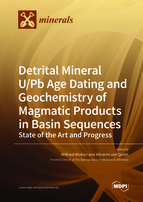Detrital Mineral U/Pb Age Dating and Geochemistry of Magmatic Products in Basin Sequences: State of the Art and Progress
A special issue of Minerals (ISSN 2075-163X). This special issue belongs to the section "Mineral Geochemistry and Geochronology".
Deadline for manuscript submissions: closed (15 April 2021) | Viewed by 46674
Special Issue Editors
Interests: sedimentation and tectonics; Basin analysis; Provenance analysis; Orogenic processes; U-Pb time scale; Lifetime of magmatic processes; High-precision CA-ID-TIMS (U-Pb system); Duration of ore forming processes
Interests: sedimentation and tectonics; Basin analysis; Provenance analysis; Orogenic processes; U-Pb time scale; Lifetime of magmatic processes; High-precision CA-ID-TIMS (U-Pb system); Duration of ore forming processes
Special Issue Information
Dear Colleagues,
The analysis of detrital zircons from sandstones has fundamentally expanded the provenance informations of siliciclastic formations and basins over the past 25 years. Siliciclastic basin research and palaeogeographic-palaeotectonic reconstructions are no longer imaginable today without the analysis of detritic zirconia for both scientific and economic purposes.
Cathodoluminescence supported laser ablation ICP-MS measurements for U-Pb geochronology and various trace elements (e.g. Th/U, eHf-ratios, REE) provide many valuable insights. First of all, the age of magnetic and metamorphic rocks in the basin hinterland will result, but not forgetting the recycling of the robust zircon grains from older sediments. The outcomes often show how complex the age patterns of supplying continental basement terranes may be, including older cores in single zircons. Tectonically driven changes in the sediment basin-source relationship due to strike-slip or basin inversion processes become visible in changing characteristics of the detrital zircons. In case of the presence of synsedimentary volcanic activity in the source areas, the maximum age of related (often) non-fossil-bearing sandstone series can be estimated. Wherefore, age correlations of Proterozoic glacial events are based on detrital zircon dating. The geochemical signatures of zircons, first and foremost the hafnium isotope ratios, provide further chief informations. Such mesurements allow to prove the formation of the original basement rocks or the syn-sedimentary melts from the Earth's mantle, crust and mixtures, which are correlated again with regional and plate tectonic processes. Published research not using both zircon geochronology and hafnium systematics appears sometimes deficient.
The proposed special issue is aimed at emphasizing the powerful role of sedimentary research in resolving geodynamic/orogenic and plate tectonic questions, and at developing further profitable methodological approaches as the use of other U-bearing detrital minerals.
Prof. Wilfried Winkler
Dr. Albrecht von Quadt
Guest Editors
Manuscript Submission Information
Manuscripts should be submitted online at www.mdpi.com by registering and logging in to this website. Once you are registered, click here to go to the submission form. Manuscripts can be submitted until the deadline. All submissions that pass pre-check are peer-reviewed. Accepted papers will be published continuously in the journal (as soon as accepted) and will be listed together on the special issue website. Research articles, review articles as well as short communications are invited. For planned papers, a title and short abstract (about 100 words) can be sent to the Editorial Office for announcement on this website.
Submitted manuscripts should not have been published previously, nor be under consideration for publication elsewhere (except conference proceedings papers). All manuscripts are thoroughly refereed through a single-blind peer-review process. A guide for authors and other relevant information for submission of manuscripts is available on the Instructions for Authors page. Minerals is an international peer-reviewed open access monthly journal published by MDPI.
Please visit the Instructions for Authors page before submitting a manuscript. The Article Processing Charge (APC) for publication in this open access journal is 2400 CHF (Swiss Francs). Submitted papers should be well formatted and use good English. Authors may use MDPI's English editing service prior to publication or during author revisions.
Keywords
- Detrital zircon U-Pb dating
- Zircon geochemistry
- Zircon double dating (FT, U-Pb)
- U-Pb dating of volcanic tuffs
- U-Pb dating of U-bearing detrital minerals
- Siliciclastic sedimentary systems
- Basin analysis
- Geodynamics






